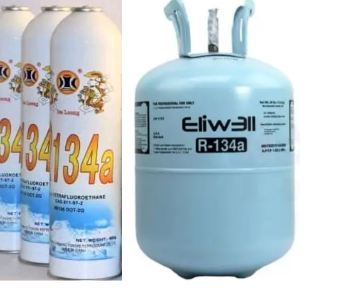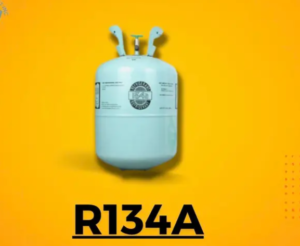R134a refrigerant is widely used in various industries, including automotive, commercial, and residential sectors, R134a has become the preferred choice for refrigeration needs.
R134a refrigerant is a hydrofluorocarbon (HFC) compound that replaced the previously used chlorofluorocarbon (CFC) and hydrochlorofluorocarbon (HCFC) refrigerants due to their harmful impact on the environment. As an HFC, R134a does not contain chlorine, making it ozone-friendly and minimizing its contribution to ozone depletion.
One of the key advantages of R134a refrigerant is its excellent cooling properties. It has a low boiling point, making it suitable for a wide range of cooling applications. Whether it’s air conditioning systems in cars, refrigerators in homes, or large-scale commercial cooling units, R134a can efficiently transfer heat and maintain desired temperature levels.
In addition, R134a refrigerant has a high thermodynamic stability, ensuring optimal performance and energy efficiency. This characteristic makes it an ideal choice for systems that require consistent cooling over extended periods.
Another notable feature of R134a is its non-flammable nature, providing enhanced safety for both residential and commercial settings. This attribute is particularly crucial when it comes to automotive air conditioning systems, where safety is of utmost importance.
However, it’s essential to understand that while R134a is widely used and considered safe, proper handling and adherence to regulations are vital to ensure its optimal performance and minimize any potential risks.
History and development of R134a
The history and development of R134a refrigerant is an intriguing journey that has revolutionized the cooling industry. Before the emergence of R134a, a chlorofluorocarbon (CFC) known as R12 was widely used as a refrigerant due to its excellent cooling properties. However, it was discovered that CFCs were contributing to the depletion of the ozone layer, leading to the implementation of the Montreal Protocol in 1987.
In response to the environmental concerns surrounding CFCs, researchers and scientists began searching for alternative refrigerants that would be more environmentally friendly. This led to the development of hydrofluorocarbons (HFCs), which do not contain chlorine and do not contribute to ozone depletion.
R134a, also known by its chemical name 1,1,1,2-tetrafluoroethane, emerged as a viable replacement for R12. It was first introduced commercially in the early 1990s and quickly gained popularity due to its improved safety and environmental profile. R134a is considered a non-ozone depleting substance and has a significantly lower global warming potential compared to its predecessors.
One of the key advantages of R134a is its compatibility with existing cooling systems designed for R12. This made the transition from R12 to R134a relatively seamless for manufacturers and consumers alike. Additionally, R134a exhibits excellent thermodynamic properties, making it an efficient refrigerant for various applications, including automotive air conditioning, commercial refrigeration, and heat pumps.
Over the years, R134a has undergone rigorous testing and evaluation to ensure its safety and performance. It has become the industry standard refrigerant for automotive air conditioning systems, and its use continues to expand across different sectors.
However, it is important to note that as environmental regulations evolve, there has been increasing scrutiny on the global warming potential of R134a. In recent years, there has been a shift towards exploring alternative refrigerants with even lower environmental impact, such as hydrofluoroolefins (HFOs) and natural refrigerants.
Properties and Characteristics of R134a
Understanding its properties and characteristics is crucial for anyone working with or using this refrigerant.
Firstly, R134a is a hydrofluorocarbon (HFC) refrigerant, which means it does not contain any chlorine and is considered ozone-friendly. It was introduced as a replacement for the ozone-depleting refrigerant, R-12.
One of the key properties of R134a is its thermodynamic efficiency. It has a relatively low boiling point of -26.3 degrees Celsius (-15.34 degrees Fahrenheit) at atmospheric pressure. This characteristic makes it suitable for applications that require low-temperature cooling, such as automotive air conditioning systems.
Another important characteristic of R134a is its non-toxic nature. It is considered safe for use in consumer and commercial applications, as it does not pose significant health risks when handled properly. However, it is still important to follow safety guidelines and handle the refrigerant with caution.
R134a also has a moderate global warming potential (GWP) of 1,430. While this is significantly lower than the GWP of some older refrigerants, it is still considered a greenhouse gas and contributes to climate change. It is important to note that there is an ongoing global effort to phase out high-GWP refrigerants, including R134a, and transition to more environmentally friendly alternatives.
In terms of performance, R134a exhibits good thermodynamic properties, allowing for efficient heat transfer and cooling. It has a high volumetric refrigeration capacity, which means it can absorb and release a significant amount of heat per unit volume. This makes it suitable for a wide range of cooling applications, from automotive air conditioning to commercial refrigeration systems.
Applications and uses of R134a refrigerant
One of the primary applications of R134a is in automotive air conditioning systems. It is the most common refrigerant used in cars, trucks, and other vehicles. R134a is known for its excellent cooling properties and is capable of providing efficient air conditioning even in hot climates. It is also widely used in commercial and residential air conditioning units, providing reliable cooling performance.
Another significant application of R134a is in refrigeration systems. It is commonly used in refrigerators, freezers, and other cooling appliances found in both residential and commercial settings. R134a’s low boiling point and high latent heat make it suitable for maintaining low temperatures necessary for preserving food, beverages, and other perishable items.
Moreover, R134a finds applications in industrial processes such as pharmaceutical manufacturing, chemical production, and electronics cooling. Its stable properties and non-flammability make it a safe and reliable refrigerant choice in these critical industries.
It is worth noting that R134a has replaced the previously used refrigerant, R12 (Freon), due to its detrimental effects on the ozone layer. R134a is an environmentally friendly alternative, as it has a lower ozone depletion potential and does not contribute to the depletion of the ozone layer.
Safety considerations and regulations for handling R134a
When it comes to handling R134a refrigerant, safety should be a top priority. This powerful substance is commonly used in automotive air conditioning systems and various other cooling applications. However, it is essential to be aware of the safety considerations and regulations associated with its handling.
First and foremost, it is crucial to understand that R134a is a colorless and odorless gas. This means that leaks or releases can go unnoticed without proper monitoring equipment. To ensure safety, always work in a well-ventilated area or use appropriate personal protective equipment such as gloves and goggles.
R134a is a hydrofluorocarbon (HFC) refrigerant, and HFCs are known for their contribution to global warming potential (GWP). As such, it is necessary to handle and dispose of R134a responsibly, following environmental regulations and guidelines. Improper disposal can lead to harmful effects on the environment and human health.
Additionally, understanding the specific regulations and laws surrounding the use and handling of R134a is crucial. Different regions may have varying requirements and restrictions, so it is essential to stay up to date with local regulations. Failure to comply with these regulations can result in legal consequences and potential harm to both individuals and the environment.
To ensure safety and compliance, proper training and certification in refrigerant handling is highly recommended. This will equip individuals with the knowledge and skills necessary to handle R134a safely and responsibly. It will also ensure that any potential risks associated with its use are minimized.
How to properly recharge or replace R134a in a system
Properly recharging or replacing R134a refrigerant in a system is crucial for maintaining optimal cooling performance. Here is a comprehensive guide on how to do it properly:
1. Assess the system: Before recharging or replacing the refrigerant, it’s essential to evaluate the system’s condition. Check for any leaks or damage that may have caused the refrigerant loss. Repairing any leaks is crucial to prevent further refrigerant loss and ensure efficient operation.
2. Gather the necessary tools and equipment: To recharge or replace R134a refrigerant, you’ll need a few key tools and equipment. These include a manifold gauge set, refrigerant recovery machine, refrigerant charging hose, safety goggles, gloves, and a certified R134a refrigerant cylinder.
3. Recover the old refrigerant: If you are replacing the refrigerant, the first step is to recover the old R134a from the system using a refrigerant recovery machine. This process ensures that the remaining refrigerant is properly removed and disposed of according to environmental regulations.
4. Evacuate the system: After recovering the old refrigerant, it’s crucial to evacuate the system. This step removes any residual moisture and air from the system, which can negatively impact its performance. Connect the manifold gauge set to the system, and use a vacuum pump to evacuate the system for at least 30 minutes.
5. Check for leaks: Before recharging the system, it’s essential to check for any leaks. Apply a refrigerant leak detector or use soapy water around fittings, connections, and components to identify any leaks. If any leaks are detected, repair them before proceeding.
6. Recharge the system: Connect the refrigerant charging hose to the low-pressure side of the system, typically the suction line. Open the valve on the R134a refrigerant cylinder and slowly charge the system with the recommended amount of refrigerant. Refer to the manufacturer’s guidelines or system specifications for the precise amount of refrigerant required.
7. Monitor system performance: Once the system is recharged, monitor its performance closely. Check the cooling capacity, vent temperature, and pressure readings to ensure everything is functioning correctly. If any issues arise, reevaluate the system and make necessary adjustments or repairs.
Remember, working with refrigerants can be hazardous, so always wear appropriate safety gear and follow safety guidelines. If you are unsure about any step or lack the necessary expertise, it’s best to consult a professional technician to ensure the job is done correctly and safely.


